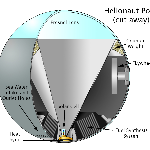
Robotic Solar Armada by Helionauts
 Jeff Harti May 5, 2015 09:29 |
Hi Abe,
Thank you for submitting your proposal.
Regards,
Jeff Harti
|
 Noah Dillon May 5, 2015 10:28 |
Everyone you know seems to love this proposal.
|
 Ted Wong May 6, 2015 05:44 |
Could you repurpose old ships?
|
 Ted Wong May 6, 2015 06:26 |
Looks like you can get a used cargo ship for a million dollars. http://www.oceanmarine.com/catalog.cfm?General-Cargo&category_current=9&category_current_sub=55
|
 John Smith May 8, 2015 11:35 | Proposal contributor
Abe,
My name is Matt Moynihan. We should talk. Let me know if your interested.
Thanks
Dr. Matt Moynihan
|
 Abe Dillon May 11, 2015 01:37 | Proposal contributor
@TedW
Thanks! I hadn't thought of checking out used ships. I think the average price per square meter of barge space could provide a good baseline for what I should expect a mass produced Helionaut hull to be. It looks a little high though. Hopefully the difference in constraints on the Helionaut hull will allow for cheaper manufacture. Purchasing a used barge for prototype purposes is an excellent idea!
@Dr. Moynihan
I'm very interested!
|
 Abe Dillon May 15, 2015 02:33 | Proposal contributor
I'm looking for help developing this idea. If anyone is interested in contributing, please contact me and I will add you to the team.
|
 Paul Klinkman May 19, 2015 09:50 |
Have you compared the cost of building and maintaining marine-grade equipment to the leasing cost per acre of desert land?
Ocean ships seem to be competing with desert land for production of synfuel or biofuel. Desert land will certainly win if winter production of algae can be achieved in desert bioreactors. See my patent #8,048,199 for one such design.
|
 Abe Dillon May 21, 2015 12:40 | Proposal contributor
@paulkilnkman
I have not compared this cost to that of desert-based bioreactors. Part of the reason is that I am having difficulty estimating the cost of my proposal due to my lack of expertise in marine engineering. My hope is that someone from Climate Colab with marine engineering knowledge will help me develop the idea.
Another part of the reason is that there is a plethora of competing ideas and performing an exhaustive comparison is neither possible nor necessary. My proposal doesn't need to be cheaper than desert-based bio-reactors. It just needs to be cheaper than fossil fuels. I have many ideas about the specific implementation of the Helionaut concept that hopefully make it cost-competitive with fossil fuel, however; the format of these proposals doesn't allow for much discussion of implementation details.
|
 Dustin Carey Jun 1, 2015 10:51 |
Hi Abe,
Thanks very much for the thought-inducing proposal.
I appreciate your novel approach to attempt to solve issues of renewable intermittency and land competition. However, I worry that this project may be a net consumer of energy. Specifically, the long voyages you're proposing will require considerable volumes of fuel to propel. This immediately puts the energy produced on these ships at a disadvantage from a holistic approach. Fuel use may alone offset the benefits of being able to position for maximum energy production. You're then proposing several conversions for the energy produced. From electricity to drawing up CO2 and conversion to synfuel to burning that synfuel for the production of electricity. With each conversion, large proportions of the original quantity of energy are lost, so that by the time you get back to electricity, you retain only a fraction of the electricity generated by solar PV alone.
Moreover, I'm unsure about the scale of production a ship would allow. Solar farms can easily cover hundreds of acres, space requirements I'm doubtful ships would be able to match, particularly at cost-competitiveness.
Just food for thought.
Best regards,
Dustin Carey
Catalyst
|
 Abe Dillon Jun 2, 2015 12:33 | Proposal contributor
Hi dmcarey,
Thanks for the input. Rest assured, I've considered all your concerns deeply while I developed this concept. Public relations is probably one of my worst skills, so please know that the following response is not intended to come off combative or defensive.
The amount of propulsion power required to move the ships varies with V^3 (where V is velocity) in the low-velocity regime. That means that if a ship reduces it's speed by a factor of 2 it requires ~1/8th the amount of power. I've calculated that Helionauts have very low propulsion requirements, they can migrate at a very leisurely pace that can be powered by kite-sails.
The proposal format doesn't lend itself well to detailed technical discussion, but the design I have in mind requires a skysail propulsion system that makes up less than 1% of the total system cost and uses less than 1% the average power supplied by the solar collectors.
I know my proposal is still very rough, but I encourage you to take a look at some of the cited resources at the end of the proposal. In particular the source about the feasibility of seawater-based fuel synthesis technology. I'm very much aware of the losses involved. Converting solar energy to synfuel is ~59% efficient. The bottom line is: if this system can produce hydrocarbon fuel which is cost competitive with fossil fuel (Im confident that it can) it doesn't matter how lossy the process was getting there. It's viable. You don't have to wait for everybody to buy an electric car. You don't have to wait for countries to overhaul their grid to better accommodate renewables. You don't have to wait 4-5 decades for all the fossil fuel power plants to be replaced by renewables. Our existing infrastructure can start burning carbon-neutral fuel right away. Then there is a clear path to reducing atmospheric CO2 by retrofitting power plants with carbon capture and storage (CCS) technology. At that point, those plants become an asset because they double as CCS plants.
It significantly less expensive/energy-intensive to extract CO2 from seawater than from the atmosphere because seawater contains ~140x the concentration of CO2 than air. Atmospheric carbon capture schemes usually require moving large amounts of air over a large exchange surface-area because of the incredibly low concentration of CO2, however; there is a natural process that forces large amounts of air flow (wind) over a large exchange surface called the oceans that we can simply take advantage of.
Solar farms are nice and should continue to be built, but utility-scale solar involves a lot of deliberation and suffers fits of starting and stopping (because funding changes every political cycle) so it often takes several years before construction even begins and another few years for construction to complete. This isn't unique to solar. It's the same for any utility-scale project that's tied to a government contract. It took a century to build the current system and it will take at least four decades and $40 trillion to replace it. If you look at market trends, growth is increasingly dominated by utility-scale projects (www.seia.org). The scalability of the Helionaut concept is one of its key benefits. They require no land, no government contract, not even dock space.
I don't see Helionauts competing with other renewable energy systems. It complements them. Just like how wind, solar, and concentrated solar thermal all complement each-other.
Thanks again!
|
 Dustin Carey Jun 3, 2015 08:12 |
Hi Abe,
Thanks for the reply. The information about the propulsion system, in particular, is very useful. That does offset my concerns about energy loss, which was largely spurred by the discussion comments which were bringing up cargo tankers. The fuel use requirements for such vessels is immense, so alternative measures are a great idea.
I agree completely that the extensive land requirements for solar farms are a significant detriment, and that your Helionauts proposal effectively mitigates that limitation. The space requirements, however, is a point of concern of mine. Simply that it would take numerous ships to match the extent of solar PV deployment of one solar farm. The conversion process of ~60% is higher than I was expecting, but the subsequent burning process to convert it back to electricity will likely also be 30-60%.
I do hope my concerns prove unfounded should your proposal be realized one day!
Cheers,
Dustin
|
 Abe Dillon Jun 3, 2015 02:01 | Proposal contributor
Dustin,
Thanks for your constructive feedback!
Summary:
My main concern is delivering competitively priced synfuel to market to displace fossil fuels. It doesn't matter how efficiently that fuel is burned. If it's cheaper than fossil fuel, it will displace fossil fuel. There are also many markets where Helionauts will outproduce ground-based solar because they can access much more insolation and they can service markets that non-synfuel-producing renewables can't (the majority of travel: planes, cars, trucks, and boats). Finally, there are many specific details about the design and production of Helionauts that provide advantages in terms of cost, efficiency, and scalability.
Long Response:
I realize the 59% loss from converting to synfuel is a big deal, but once the energy is converted to synfuel I don't need to worry about losses further down the line. All I need to worry about is: can my synfuel compete against fossil fuels in the market. If it can, then; from the consumer's perspective the system is efficient and cheap enough to succeed. The goal is to displace fossil fuels, not to break efficiency records. You could have the most efficient solar array in the world, but it will never power a jet airplane, It won't power the hundreds of millions of automobiles with ICEs, and It will take years for a utility-scale system to be built.
In the best case scenario: a land-based utility-scale system would be built close to the equator where it will get an average insolation of 250 watts per square meter (w/m^2), but if you're trying to power Seattle, Boston, New York, London, or any other city far from the equator, you either need one hell of a super grid, or you need to build it close to the point of consumption where it will get an average insolation closer to 100 w/m^2. A Helionaut can access an average insolation of over 500 w/m^2, so in many markets, Helionauts would still outproduce land-based systems.
What's more, the Helionaut design can take advantage of its marine operating environment to simplify several key design problems in concentrated solar power. The cost of concentrated solar power is largely inflated by the added complexity of a tracking system (especially one that can operate under high wind load) and a cooling system. A Helionaut pod is simply a sphere with the top half comprised of a fresnel lens and the bottom half made of a thin sheet of marine-grade steel. Inside the sphere is a target that the fresnel lens focuses light onto and some reaction wheels to adjust the orientation of the pod (and amongst other equipment). The sphere's buoyancy is adjusted so that it is half submerged in the ocean and the back plate serves as a sufficient heat-sink because water has over 25 times as much cooling capacity as air. There is essentially no wind load, so none of the tracking equipment has to be built to ridiculously high (and expensive) specifications and the reaction wheels (google "cubli" to get an idea of what I'm talking about) can be minimized by using flexible technology like that used in Velkess flywheels. The reaction wheel system would be internal, so it wouldn't have to be made to marine-grade standards and it would offer great disturbance rejection and efficient tracking. This all adds up to cheaper concentrated solar power. The reason that's such a big deal is: we've known for a long time that concentrated solar power has the potential to be the most efficient and power-dense form of solar power, but it's adoption has been slow due to the added cost and complexity of a tracking system that can work under heavy wind load and a cooling system that can handle the intense heat (and the fact that solar concentrators aren't very practical in the residential and commercial market).
Yet another reason Helionauts will end up being cost competitive despite the added conversion losses: They can be truly mass produced. We can practically build an assembly line that goes straight into the ocean. Utility-scale solar plants do use a lot of off-the-shelf components, which helps, but each one is a new design that must go through a long planning phase. Helionauts can achieve continuous, uninterrupted production and help drive Swanson's law.
Finally, I'm interested in testing out a new technology known as the Johnson ThermoElectric Converter (JTEC) which may allow not only more efficient solar energy collection, but more efficient power-plant and automobile operation. I'm also planning on exploiting the phenomenon of chromatic aberration (which happens naturally in fresnel lenses) to separate the solar spectrum into its constituent frequencies and use a vertical target made up of stripes of narrow-band cells to achieve equivalent or better efficiency than a multi-junction cell without requiring the expensive manufacturing process and complex material constraints. Those cells in conjunction with a JTEC could, in theory, result in extremely high efficiency over (50-70%).
I realize that that's a lot of unproven technology, so I don't plan on packing it all into version 1.0 of the Helionaut design, rather, I will release a simple system based on proven technology first, then include novel improvements as they are vetted by R&D prototyping.
If we can persuade law makers to adopt adequate cap-and-trade policies, we might even be able to sell synfuel at a discount due to the amount of carbon sequestration it represents. Assuming a $25/ton CO2 credit, that represents a discount of $0.22 per gallon of gasoline ($0.06 per liter of petrol if you like). Not a game changer, but it would help.
I hope that addresses your concerns. I'd be happy to answer any other questions you have or clarify any of the above. I'd also be happy to work with people with expertise in areas that I'm deficient in because as I continue developing this idea, I uncover more and more questions that I don't have the expertise to answer. My main goal for creating this proposal is not to win the contest, but to share the idea with others who can collaborate with me to take it further.
|
 Dustin Carey Jun 3, 2015 09:11 |
Abe,
Thanks very much for the length reply. The supplementary explanations certainly did help reinforce the proposal, and makes it seem all the more a viable project. Very best of luck with it!
Cheers,
Dustin
|
 Michael Hayes Jun 16, 2015 08:33 |
Hi Abe,
In your proposal you state that "Our solution is to use solar energy to extract CO2 from the oceans where it is 140 times more concentrated than in air.[4] We can then use the CO2 to synthesize fuel (synfuel) and sell the fuel to finance the operation.".
In general, I'm highly supportive of the basic concept of using marine resources as a strong player in getting us to a carbon negative scenario.
Your premise that it takes energy to extract CO2 from the oceans may be, however, needlessly complex.
The perpetual salt fountain offers an 'energy free' means/method for obtaining both CO2 and nutrients from the ocean water.
The perpetual salt fountain is shown in many of my proposals, such as:
https://www.climatecolab.org/web/guest/plans/-/plans/contestId/1301413/planId/1314306
https://www.climatecolab.org/web/guest/plans/-/plans/contestId/1301501/planId/1315115
https://www.climatecolab.org/web/guest/plans/-/plans/contestId/1301411/planId/1314308
I hope this helps.
Michael
|
 Abe Dillon Jun 17, 2015 01:33 | Proposal contributor
Thanks, Michael. Sorry my proposal isn't more clear. Very little of the energy collected goes into CO2 extraction. Most of it goes into fuel synthesis. This is not just a means to sequester CO2, but a way to rapidly transition to renewable energy.
|
 Chad Knutsen Jul 10, 2015 04:28 |
Very cool idea. I see a few advantages that this proposal could have over desert based solar farms.
a) Solar farms have actually been known to interrupt the migratory patterns of lots of wildlife, and even have been reported to ignite a few birds who flew past the focal point at the wrong time...(yeesh, icarus much?!).
b) solar farms also take up large swaths of land, which may not seem like a problem now, but down the road, we may want to find alternatives to covering huge amounts of land with giant reflectors that could, in theory have the potential to heat up our atmosphere if built in sufficient numbers...
c) Also, solar panels are still fairly expensive to manufacture. And if the $/Watt ratio is comparable to that of solar, and it takes up less space, and causes less environmental concerns, this proposal could take the cake.
Of course there are still numerous technical things to work out, but thats why we're all here right?
Cheers mate on the great project. Would certainly like to contribute in whatever way I can. Feel free to message me if you'd like help raising funds, or attracting investors etc.
|
 Chad Knutsen Jul 10, 2015 04:09 |
also, please check out my proposal in the Buildings Contest: http://tinyurl.com/hempstone
|
 Khalid Grant Jan 12, 2016 12:06 | How much land do you need for a prototype; the smallest scale you can get it down to? How much capital do you need to get started? |
 Khalid Grant Jan 12, 2016 12:49 | How much land do you need for a prototype; the smallest scale you can get it down to? How much capital do you need to get started? |